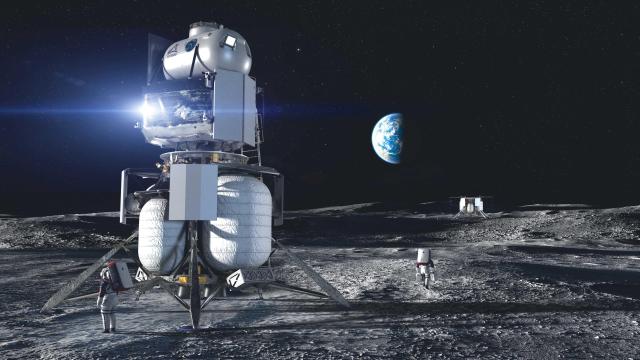Blue Origin is once again making a pitch to build a lunar lander for NASA’s Artemis program. The space company is partnering with Lockheed Martin, Boeing, Astrobotic Technology, Honeybee Robotics, and Draper in hopes of building a second lander, Blue Origin announced on Tuesday.
Earlier this year, NASA formally announced its intention to procure a second lunar lander for its Artemis program, so it comes as little surprise to learn that Jeff Bezos’s Blue Origin is once again hoping to snag a deal.
The private space company had previously attempted to lock down a NASA contract for the first Human Landing System (HLS), but lost to its rival SpaceX last year. The first time around, Blue Origin had partnered with Lockheed Martin, Northrop Grumman, and Draper to form the “National Team,” but for its second kick at the lunar can, the company has ditched Northrop Grumman and added Boeing, Astrobotics, and Honeybee. Blue Origin didn’t offer much more information than that, or how it plans to win NASA’s contract (as an aside, SpaceX isn’t allowed to make a bid, as it will be developing its own second lander under Option B of its contract, but more on this in just a bit).
Bezos didn’t take the L gracefully last time, filing a lawsuit against NASA with the U.S. Court of Federal Claims over the space agency’s decision to award SpaceX the first lunar lander contract. Life is all about second chances, however, with Bezos now hoping that his revised space team has what it takes to land humans on the Moon.
The second lunar lander will be similar to the first in that it needs to be capable of delivering astronauts from lunar orbit to the Moon’s surface and then back to lunar orbit. It will also need to dock with the lunar Gateway, a planned orbital outpost around the Moon that will support the Artemis program’s goal of having a sustained presence of humans on the Moon.
NASA recently kicked off its Artemis program with the launch of its Orion capsule, which is currently on its way home from the Moon. The Artemis 1 mission is uncrewed, but the upcoming Artemis 2 mission — basically a repeat of Artemis 1 — will involve a crew of four astronauts. It won’t be until Artemis 3, scheduled for no earlier than 2025, that NASA intends to place astronauts onto the lunar surface.
In 2021, NASA signed a $US2 ($3).89 ($4) billion contract with SpaceX to develop a human landing system for Artemis 3. Blue Origin, along with its partners, were asking for a $US5.99 ($8) billion contract. After it lost the bid, Blue Origin claimed that NASA’s bidding process was unfair. Bezos even wrote an open letter to NASA’s Bill Nelson in July, pleading for an extended contract in return for a waiver of all payments up to $US2 ($3) billion. The company also called out what it claims are deficiencies in SpaceX’s HLS solution, pointing to its unproven Starship platform, which is yet to fly.
But NASA recently doubled down on its SpaceX choice, awarding Elon Musk’s space company a $US1.15 ($2) billion contract to develop a second lunar lander for its Artemis 4 mission. The mission wasn’t originally planned to land astronauts on the Moon, but the space agency had a change of heart. As a result, NASA pursued Option B of its contract with SpaceX, in which the Elon Musk-led company will develop a modified version of the first lunar lander.
NASA is putting a lot of trust into SpaceX, but the space agency isn’t about to put all of its eggs into a single basket — particularly a basket led by the tumultuous Musk. The space agency is seeking a sustainable and prolonged return to the Moon, so it makes sense for NASA to work with multiple private partners and have multiple options at its disposal. It’s reminiscent of the Commercial Crew program, in which SpaceX successfully delivered the Crew Dragon capsule, while Boeing has yet to deliver Starliner. Perhaps something like this will happen with HLS — who knows? The need for vendor diversity likely prompted NASA’s call for proposals from other U.S. companies to develop the second, non-SpaceX lunar lander, which will seemingly be used for the Artemis 5 mission.
“Competition leads to better, more reliable outcomes,” Nelson told reporters in March. “It benefits everybody. It benefits NASA. It benefits the American people.”
SpaceX and Blue Origin are key players in the private space industry at the moment (or at least, Blue Origin is hoping to be!), so a little healthy competition between them is expected — even if the billionaires in charge aren’t accustomed to losing.
More: Billionaires Sent to Space Weren’t Expecting to Work So Hard on the ISS
